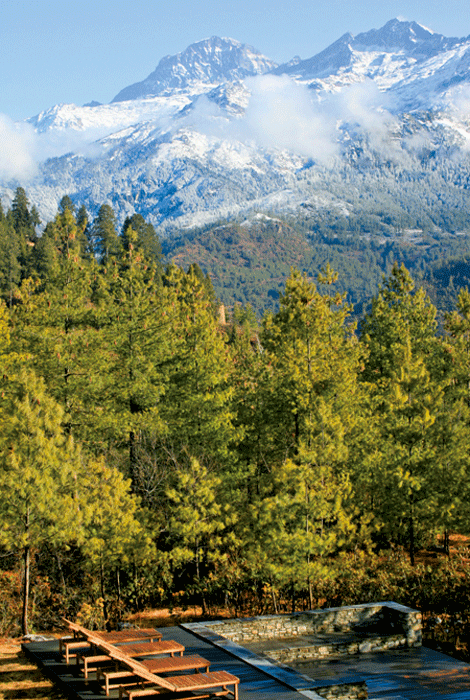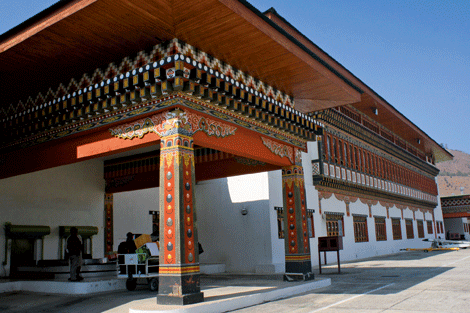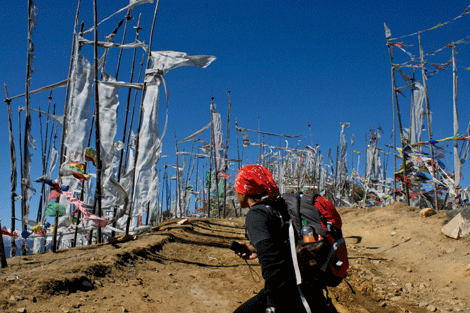In the days leading up to my trip to Bhutan, some particular necessities of travel to this last Shangri-la began to surface. Credit cards are not readily accepted, prompting me to wire US dollars to Druk Air’s Thai bank account to pay for my Bangkok to Paro flight. There are no international bank machines, leading me to bring enough US$ bills for my 10-day stay. At the height of winter, the temperature is close to freezing. “Layer, layer, layer!” an acquaintance and frequent visitor to Bhutan advised me. Gloves, boots, ear bands, thermals and scarves are necessary. But a Bhutanese lady gave me the best advice: “Don’t forget to bring your lip-gloss and sun block” – the sun and wind are quite strong in this high-altitude destination.
There was a gentle reminder from the conference organisers not to bring in cigarettes, as smoking is illegal in Bhutan, and I was warned of the abundance of chilli and cheese in Bhutanese meals. While I have an adventurous palate, I armed myself with tablets to address my lactose intolerant stomach. Finally, a guidebook tipped me off to ask for a window seat on the left side of the plane.

Landing high
The pilot manoeuvred masterfully through the Himalayan peaks, making a spectacular approach between the mountains before landing on the airport’s runway. In the gorgeous airport building, with its ornate hand-carved and hand-painted cornices, the immigration officials were dressed in the man’s traditional long robe, or gho, paired with black knee-high socks and leather shoes.
But no one had warned me of the crux of the tourist experience in Bhutan: the tour guide. Tourism is the second highest revenue source in the country. With a clever system in place for a US$200 to US$250 daily tariff, visitors are in the hands of their minders from their arrival at the airport until departure. Thirty-something Kinley was waiting for me, his sleek locks doused with too much hair product, but still dressed in the traditional gho. Tour guides are the curators of your experience, deciding where and when you eat, sleep, and shop. There is no language barrier as they speak fluent English – the language of instruction in schools – as well as their national language Dzongkha and several of the 19 dialects, including Nepali.

The acclimatisation process
As I marvelled at Bhutanese architecture, the vast mountains and my first sightings of colourful prayer flags, Kinley said: “I hope you’re not hungry yet. We will have lunch in Thimphu.”
Thimphu is Bhutan’s capital and largest city, and the restaurant we were taken to was Bhutan Kitchen, apparently a popular choice among tour guides for the introduction to the country’s cheese-based cuisine. This was the first of many buffet spreads of shemu-datsi (mushroom cheese), ema-datsi (chilli cheese), kawa-datsi (potato cheese) and gundo-datsi (Egg cheese) – the chilli version being the most popular, served for lunch and dinner along with fresh vegetables and locally produced red rice.
Over 2,000 metres above sea level, the high altitude leaves you light-headed for the first 24 hours. But I still noticed the huge influence of Vajrayana Buddhism on all aspects of life in Bhutan. They do not kill animals, and at the National Memorial Chorten (Stupa), bells rang as devotees repeatedly spun the large metal prayer wheels, circumambulating in a clockwise direction to gain merit.
Just a few hours in Bhutan convinced me of the merit in having a guide, someone to act as an effective translator of this unique culture, and efficiently transport you to distant attractions.
Exodus to Punakha
The next day, another guide called Ugyen, along with his driver Gopal, accompanied me to Punakha, the winter residence of the monks. The journey proved to be as memorable as the destination; after a dizzying, hour-long, zigzagging drive we arrived at Dochula Pass – which presented the magical sight of 108 stupas surrounded by snow-carpeted hillsides, and in the distance snow-capped Himalayan peaks piercing the sky.
In a country known for its Gross National Happiness, a series of happy coincidences began to occur. Stopping at a restaurant for lunch, I met Tom and Sara, a British couple nearing the end of their 11-day holiday in Bhutan. Nearby, two Chinese ladies from Shenzhen were happily conversing in fluent Mandarin with their Bhutanese guide. Ugyen shared his big plan to head to Beijing later this year to learn Mandarin in anticipation of a growing number of Chinese tourists in coming years.

We continued on to Punakha, where Buddhist monks reside during the winter months. At a monastery built by the royal family two years ago for 25 Buddhist nuns, two rather shy nuns unlocked the doors to the temple. Evening prayers were about to begin, allowing us to witness the solemn chanting, the drums beating, and feast our eyes on the paintings, golden statues and colourful fabric chandeliers inside the temple.
The next day, I walked into the almost 450-year-old Punakha Dzong, known as the Palace of Happiness. The sprawling six-storeyed rectangular tower was stunning. In another lucky stroke of timing, I was in time to see the monks silently savouring their morning meal. Experiences are not staged in Bhutan for tourists; instead, magic happens when you experience authentic encounters. Walking to Chimi Lhakhang Temple, frequented by childless couples praying for fertility, I gazed at houses splashed with vivid paintings of phallic symbols. Inside a small wooden shack, an old woman was toasting rice in sand to make a traditional puffed-rice snack called Zaw.
Small-town charm
When I reached Paro Valley, the rice bowl of the kingdom, I once again encountered Sara and Tom. Over a dinner of more ema-datsi and red rice, I probed them. “Are you dzong’d out?,” I asked. They laughed – we had all experienced the overwhelming introduction to numerous symbolic deities. “One temple had a painting identifying all the gods,” said Tom. “Just when I thought I had it clear in my head, I walked into the next room. Each of these gods have past, present and future counterparts.”
Being seasoned travellers, they were initially uncomfortable about submitting to their guide’s agenda, wondering how long he could sustain their interest with countless visits to temples and dzongs. Surprisingly, they enjoyed the whole trip, as the districts and valleys of Bumthang, Thimphu, Punakha, Paro and Haa each had a different feel. At a table close by, our guides were feasting, too, drinking bottles of Druk 11000 beer. After 10 days together, Tom and his guide were best buddies, with a secret handshake greeting.
The pinnacle of a trip to Bhutan is often the visit to Tiger’s Nest, the kingdom’s most picturesque Taktsang Monastery perched on the side of a 900-metre cliff above the Paro Valley. Revered as a sacred place, it is believed that all Bhutanese should visit the monastery at least once in their lifetime. From the roadside, the monastery appears to be a tiny speck barely visible to the eye. Its high elevation both intimidates and intrigues.
Determined to complete the pilgrimage, I hired a horse to take me halfway up the mountainside, but higher up the steep steps had to be gingerly negotiated on foot. Despite being an iconic image on postcards and a religious pilgrimage site, we met only a handful of people on the path. I recognised a couple I had spotted in a restaurant in Punakha. “Hola!” called the Chilean mother I had met in Travellers Restaurant a few days earlier, along with her four daughters, as they powered briskly through the hike in record time.
It is this small-town vibe that makes Bhutan charming. People know each other. In a few days, even tourists become familiar with each other. Famously, there are no traffic lights anywhere in the country, with only a white-gloved policeman directing traffic at Thimphu’s busiest street intersection. As we strolled down the main street, Isabel, one of 600 expats in a nation of 700,000 people, pointed to a new mall: “That’s the first escalator in the country!”
Bedding down in Bhutan
Despite having only one escalator, Bhutan does not lack facilities for the growing number of tourists. There are over 900 accredited tour operators, and over 1,000 licensed tour guides, but with 128 hotels in the country occupancy rates are low. The quality of accommodation varies greatly, from small budget hotels with no hot showers, inadequate heating and no front desk receptionist past midnight, to celebrity-favoured premium five-star properties.
A top pick among ADB officials and other notables doing business in Thimphu is Taj Tashi. This 66-room hotel is in the centre of town, within walking distance of the market and main street shops. But tourists often prefer to stay in Paro – the valley is more scenic and peaceful than Thimphu, with only 39,000 residents compared to the capital’s population of 101,000. The ever-popular Tiger’s Nest is also located in Paro, making it a convenient choice. Here, the Zhiwa Ling, a Bhutan-owned, five-star hotel boasts traditional architecture, with modern touches like Swedish floor heating convenient for the cold winter nights.
Uma by COMO, Paro boasts expansive views of Paro Valley from its 29 rooms and villas, which are sleek and modern inside, while the exteriors are authentically Bhutanese, using no nails in their construction. The cosy hotel’s centrepiece is its circular restaurant, allowing 360-degree views of the pine trees outside. The food is equally stunning, the authentic Southeast Asian flavours particularly welcome after a week eating ema-datsi and other Bhutanese dishes – appetising and filling though they are.
For most, a visit to Bhutan happens only once in a lifetime, so splurging to stay at an Aman property can make it a fitting experience. After a sun-drenched journey through the kingdom it rained on my last day, but arriving in the forest that surrounds Amankora Paro no amount of rain could dampen my mood. It proved to be the perfect day to sit in my room, made with natural rammed-earth walls and designed for maximum appreciation of the trees and mountains outside. To keep me warm and toasty, my butler built a fire in the bukhari, a charming wood-burning stove inside my room.
Come evening I finally succumbed to an authentic hot-stone bath, a medicinal Bhutanese tradition. Huge river rocks heated for many hours are dropped in a bath filled with local herbs. The hot bath soothed my tired body from days of mountain travel, and a Bhutanese lady then worked her magic, kneading my aches and pains away. It was pure bliss. After a sumptuous Indian meal, I had the most restful sleep in my entire stay in Bhutan.
I woke to find the sun shining once again, and when I stepped from my room the mountains were revealed with a brand-new dusting of snow. Minutes later, bells were ringing cheerfully. A monk solemnly gave me his blessings for the journey as I prepared for my final trip to the airport. And in this magical kingdom, I truly did feel blessed.
Useful Facts
Getting there
National carrier Drukair-Royal Bhutan Airlines operates daily flights to Bangkok via Dhaka. It also flies to Kathmandu in Nepal, and Kolkata, Delhi, Gaya, Guwahati and Bagdogra in India, and began twice-weekly flights to Singapore in September.
Visas
All visitors to Bhutan need a visa. Visas are issued only when a confirmed booking through a tour operator has been made. See www.tourism.gov.bt for a list of operators and tour packages.
High-value,
low-impact tourism
Bhutan only opened its doors to tourism in 1974. Recognising the problems associated with mass tourism, it regulates tourist arrivals, and there is a minimum daily tariff that, starting January 2012, will be US$250 per person per day in the high season (March-May and September-November) and US$200 for the rest of the year. The tariff covers all internal taxes, charges including royalty, accommodation, all meals, service of licensed guides, internal transport, camping equipment and haulage for trekking tours. The royalty portion goes to the government exchequer, which supports free medical care, free education and other welfare schemes.
Where to stay
Amankora Paro
Tel +975 8 27 23 33
Email: [email protected]
Taj Tashi
Tel +975 2 33 66 99
Email: [email protected]
Uma by COMO, Paro
Tel +975 8 27 15 97
Email: [email protected]
Zhiwa Ling
Tel +975 8 27 12 77
Email: [email protected]








